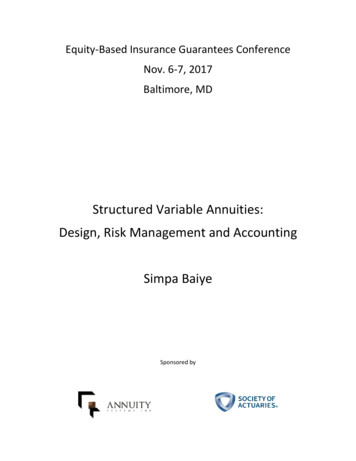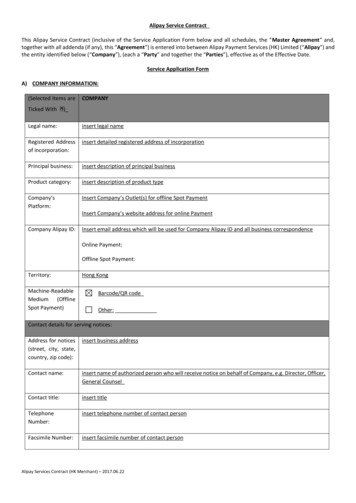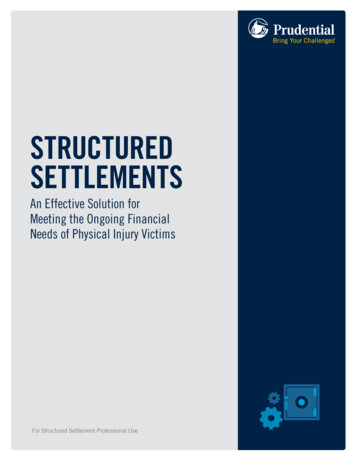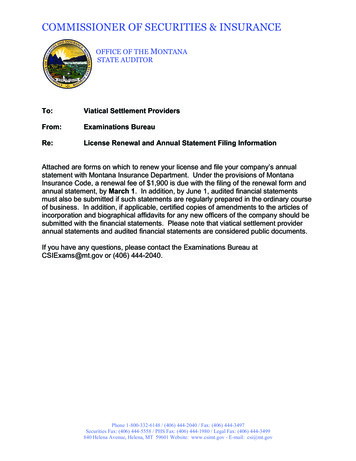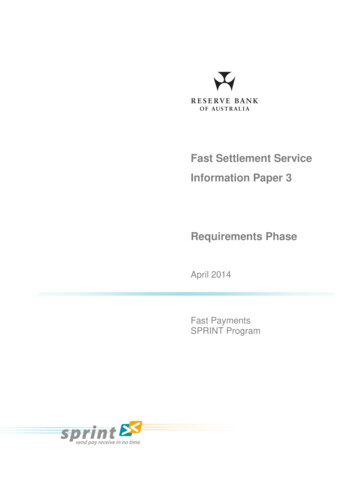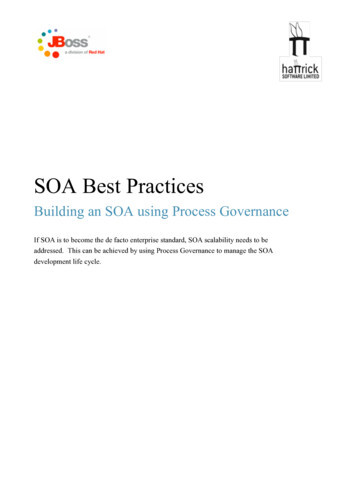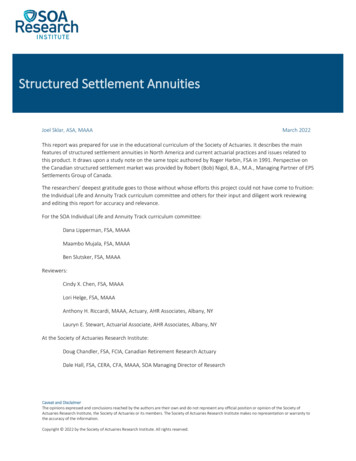
Transcription
Structured Settlement AnnuitiesJoel Sklar, ASA, MAAAMarch 2022This report was prepared for use in the educational curriculum of the Society of Actuaries. It describes the mainfeatures of structured settlement annuities in North America and current actuarial practices and issues related tothis product. It draws upon a study note on the same topic authored by Roger Harbin, FSA in 1991. Perspective onthe Canadian structured settlement market was provided by Robert (Bob) Nigol, B.A., M.A., Managing Partner of EPSSettlements Group of Canada.The researchers’ deepest gratitude goes to those without whose efforts this project could not have come to fruition:the Individual Life and Annuity Track curriculum committee and others for their input and diligent work reviewingand editing this report for accuracy and relevance.For the SOA Individual Life and Annuity Track curriculum committee:Dana Lipperman, FSA, MAAAMaambo Mujala, FSA, MAAABen Slutsker, FSA, MAAAReviewers:Cindy X. Chen, FSA, MAAALori Helge, FSA, MAAAAnthony H. Riccardi, MAAA, Actuary, AHR Associates, Albany, NYLauryn E. Stewart, Actuarial Associate, AHR Associates, Albany, NYAt the Society of Actuaries Research Institute:Doug Chandler, FSA, FCIA, Canadian Retirement Research ActuaryDale Hall, FSA, CERA, CFA, MAAA, SOA Managing Director of ResearchCaveat and DisclaimerThe opinions expressed and conclusions reached by the authors are their own and do not represent any official position or opinion of the Society ofActuaries Research Institute, the Society of Actuaries or its members. The Society of Actuaries Research Institute makes no representation or warranty tothe accuracy of the information.Copyright 2022 by the Society of Actuaries Research Institute. All rights reserved.
2CONTENTSSection 1: Overview of Structured Settlements .31.1 History of Structured Settlements . 31.2 Forms of Benefit Payments under a Structured Settlement . 4Section 2: Pricing Considerations .42.1 Mortality . 42.2 Interest Rates . 52.3 Expenses and Premium Taxes . 62.4 Post-tax Return on Invested Surplus . 62.5 Administration of Pricing and Rate Changes . 6Section 3: Risk Considerations .73.1 Mortality Risk . 73.2 Interest Rate and Asset / Liability Mismatch Risk . 73.3 Credit Risk . 83.4 Impact of Benefit Escalators on Risk . 83.5 Risk-Based Capital . 8Section 4: Reserving / Valuation Methodology .84.1 Statutory Reserving . 94.2 GAAP Reserving . 9Section 5: Other Considerations .95.1 Taxation . 95.2 Attorneys’ Fees. 95.3 Factoring .105.4 Inflation Considerations.105.5 Canadian Market .10About The Society of Actuaries Research Institute.11Copyright 2022 Society of Actuaries Research Institute
3Section 1: Overview of Structured SettlementsA structured settlement annuity is a contract that provides periodic benefits to a plaintiff, stemming from tortsettlements of various types of claims. These annuities are used to settle personal injury or wrongful death claimsarising from accidents, medical malpractice, workers’ compensation cases, and other causes. Structured settlementstake their name from the fact that the payment streams are frequently customized to fit the circumstances of theinjured party and/or the injured party’s dependents. For example, they can provide regular income streams to meetongoing medical or care needs to egregiously injured plaintiffs, or deferred payments over four years to providecollege education funding for minors in wrongful death claims where a parent’s life was lost. These contracts arefinanced through a single premium amount funded by the defendant or their insurance company. The benefitpayments that the plaintiff receives under a structured settlement are not subject to personal income taxation.Structured settlements have received increased recognition over time for the advantages they present to bothplaintiffs and defendants, as well as constituting good public policy. Periodic and deferred payments have beenencouraged and even mandated in some states as a means of controlling costs under malpractice claims andensuring that the monies would be available in future years and not squandered as could happen with lump sumpayments. In addition, such payment arrangements can relieve the plaintiff from the need to invest and manage theproceeds of a large settlement. For these reasons, structured settlements are credited with reducing encumbranceson government benefit programs and are generally viewed very positively by policymakers.Structured settlements are often the result of a pre-trial settlement. They also may come about during the appealsprocess, when an initial court verdict is being challenged. In some instances, especially in cases involving minors,structured settlements are imposed by statute or by judicial authority.Structured settlement annuities are marketed through a very specialized field force. Consultants for the firms thatspecialize in this field help negotiate tort settlements and work with insurance companies to provide the annuitiesthat fund such settlements. These consultants normally work closely with the defendants or their insurers and arecompensated only through commissions earned on the sale of the annuity contracts.A structured settlement arrangement has been consummated when the defendant (or their casualty insurer) agreesto pay the plaintiff/annuitant a stream of specified benefit payments in return for releasing the defendant from thetort claim. In order to fund the benefit stream, the defendant purchases an annuity contract from a life insurer.Many times, the arrangement will then include what is known as a “qualified assignment”, where the defendant (ortheir casualty insurer) transfers the liability for the future payments to a third party, the “assignee.” The assigneecompany will then own the right to the annuity payments, together with the obligation to make the specifiedbenefits payments to the plaintiff/annuitant. The assignee company is often a subsidiary of the life insurer providingthe structured settlement annuity. Assignments of this nature allow the defendant (or casualty insurer) to closetheir books on the settled claim.Note that the discussion here on the structured settlement market and practices is primarily focused on the UnitedStates. Any reference to Canadian practices is specifically noted, and primarily occurs at the end of the paper in theOther Considerations section.1.1 HISTORY OF STRUCTURED SETTLEMENTSThe earliest recorded use of structured settlements is believed to have occurred in Canada in the 1960’s. The drugThalidomide was associated with birth defects, and when the drug’s manufacturer exhausted its insurancecoverage, it started to settle cases through agreements to make lifetime payments rather than through one-timelump sum settlements. In the United States, uncertainty over the tax treatment of the payments limited the marketuntil the Internal Revenue Service issued a favorable revenue ruling in 1979. In the Other Considerations sectionbelow, more information is provided on the taxation of structured settlements.Copyright 2022 Society of Actuaries Research Institute
4The structured settlement market has grown considerably since those early days. Courts have increasingly realizedthe societal good provided by settlements that provide money over time to best match a plaintiff’s ongoing needs.Judges have become more active in encouraging or in some cases requiring the use of periodic payment settlementin lieu of one-time lump sums.1.2 FORMS OF BENEFIT PAYMENTS UNDER A STRUCTURED SETTLEMENTThere are several different modes of benefit payment that are used to provide the desired flexibility whenstructuring the settlement of a personal injury claim.Annuity Certain: a stream of specified benefit payments made at periodic intervals over a predeterminednumber of years. These payments are not dependent on the survival of the annuitant and will be madeto the annuitant’s estate or named beneficiary if the annuitant should die prior to the end of thecertain period.Single Life Annuity: a stream of specified benefit payments made at periodic intervals over the duration of anannuitant’s lifetime.Temporary Life Annuity: a stream of specified benefit payments made at periodic intervals only if the annuitantis alive, with such payment stream having a specified end date.Lump Sum: a single payment made at a specified future date, can be either life contingent, which means that itis only paid if the annuitant is alive on the future date, or certain. Many times, the settlement may callfor a series of lump sums, such as payments to be made every five years for a certain period of time.While the annuity types above are not typically indexed to cover actual emerging inflation, they may be specified toincrease at a fixed rate (such as 2% or 3%) annually as a way of providing coverage for future inflation.Additionally, it is common for a single life annuity to have a certain period attached to it. As an example, a single lifeannuity with a 10-year certain period would guarantee payments for the first 10 years, and benefit payments afterthat time would be dependent on the annuitant’s continued survival.Section 2: Pricing ConsiderationsThe pricing framework for a Structured Settlement Annuity must take into account multiple considerations. Thereare several significant assumptions that are needed, such as interest rates, mortality, and expenses. The frameworkmust take into account reserve levels and required capital, which will likely result in a phenomenon known assurplus strain, along with profitability targets. Finally, the insurer’s practice around the communication of ratechanges and guarantee periods to the specialized consultants who operate in this market is an importantconsideration.2.1 MORTALITYMortality assumptions will be necessary to generate the expected benefit cash flows whenever there are lifecontingent payments. As discussed earlier, life contingent cash flows can take the form of a life annuity, a temporarylife annuity, or life contingent lump sums.Developing appropriate mortality assumptions can be a real challenge for structured settlements. The annuitantpopulation tends to be dramatically different than that for any insured population, including annuities intended tofund retirement income. Structured settlement annuitants tend to be much younger when the annuities are issued.Since the annuities are used to fund a tort settlement, there isn’t the type of longevity-related anti-selection thatexists with other life annuities. Structured settlements are a niche market, making it unlikely that any singlecompany will have sufficient credibility based on their own experience. The Society of Actuaries (SOA) conductsindustry mortality studies which most companies find helpful in complementing their own emerging experience.Copyright 2022 Society of Actuaries Research Institute
5If the plaintiff/annuitant has significant injuries or a medical condition which will result in a reduced life expectancy,underwriting will be necessary. When underwriting annuities, the age used to determine the purchase price isadjusted. This will likely result in an age “rate-up” to reflect the biological or physiological age of the plaintiff at thetime of underwriting, as compared to their chronological age. Unlike life insurance, such a substandard designationwill be favorable in the pricing of life contingent payments, as the impairment will reduce the expected cash flows.The substandard structured settlement will then be priced based on the rated age instead of the annuitant’s actualage. While this method may lack precision, it is a widely used simplification that is convenient in communicatingwith the specialized consultants and other participants involved in arranging structured settlements.Substandard underwriting is a complicated area for companies in this market. Many companies use their lifeunderwriters to assign the rated age. However, the type of impairments that they need to rate for structuredsettlement cases present a very different profile than those typically experienced with life insurance applicants. Bythe nature of the causes of the tort actions that lead to structured settlements, many of the annuitants beingunderwritten have experienced physical trauma such as brain injuries and spinal cord injuries. The more traditionallife underwriting issues of obesity, cardiovascular disease, diabetes, and so on make up a very small percentage ofstructured settlement cases being underwritten. Often the underwriters will look to determine a future lifeexpectancy for the impacted annuitant, and then translate that into a rated age.The pricing actuary must also consider, however, that even if the underwriter has successfully assessed theremaining life expectancy of the substandard annuitant, the mortality curve will likely be different than that for anaverage person whose chronological age is the same as the annuitant’s rated age. For example, a 20-year-old whoreceives a 30-year age rate-up will be rated age 50 at issue. If such person is still alive in 40 years, at theirchronological age of 60 at that point they will likely have much lower mortality going forward than someone who isactually 90 years old.The mortality considerations above help establish the base mortality assumption, but don’t account for expectedmortality improvement over time. For structured settlement annuities, it is common practice to use a onedimensional mortality improvement scale (i.e. only differs by age and gender, not year of issue cohort). Manycompanies use an existing industry improvement scale, such as G2, perhaps with some adjustments that reflecttheir individual views of future mortality improvement.2.2 INTEREST RATESA crucial step in pricing structured settlements is developing a discount curve to calculate a net present value of theprojected benefit cash flows. The interest rates used in the discount curve are based on the yields a company canattain on newly purchased assets. In order to construct such a curve, company actuaries must work closely withportfolio managers to determine appropriate asset types.The benefit payments under a structured settlement are fixed and determinable, with the only uncertainty beingvariation in actual mortality compared to expected for life contingent payments. For this reason, companies cansafely invest in less liquid asset types, such as private placements and mortgage loans. These asset types are onlytypically available for short and intermediate maturities. Publicly traded fixed income securities, such as Treasuriesand corporate bonds, are commonly available for up to 30 years.Companies can choose to invest a certain portion of their portfolio in “high yield” bonds, generally referring tobonds of credit qualities rated BB and below. However, investing in lower grade bonds will result in a higher marginnecessary for the risk of default, and will also increase the required capital the company must hold. Nevertheless, aprudent allocation to lower quality assets may prove advantageous in pricing.Structured settlements are known as “long-tail” liabilities, meaning that the benefit stream can extend over a verylong timeframe. Take the example of a life annuity on a 20-year-old, where some level of expected benefit paymentCopyright 2022 Society of Actuaries Research Institute
6will be due for more than 60 years. The investment horizon extends for only around 30 years, so there will besubstantial liability cash flows due beyond that period. For this reason, it will be necessary to make an interest rateassumption to discount liability payments beyond 30 years. This inability to match all the projected cash flowscreates “reinvestment risk”. There are various strategies that companies can use in an attempt to match the longduration of structured settlement benefit cash flows, including investing in derivative instruments like futures andswaps. These reinvestment risk mitigating strategies will be discussed further in the Risk Considerations sectionbelow.A gross yield curve results from the above process, reflecting different yields available at different maturities basedon a company’s investment strategy. Margins will then need to be deducted from those gross yields to reflect assetrelated items such as investment-related expenses and expected defaults. Liability-related margins can be used tofactor in expenses, but there are also other ways to provide for expense coverage in pricing (see below). Finally, anadditional margin is deducted from the gross yield to provide for a target level of profitability.2.3 EXPENSES AND PREMIUM TAXESThe expenses that the insurer incurs when initiating and maintaining the structured settlement annuity will need tobe incorporated into the pricing. Also, as is the case with all product lines, the expense structure will need to factorin a portion of the writing company’s overhead. Expenses can be covered in pricing in several ways. It may seem likea best practice to attempt to do so in a manner that can accurately reflect the dynamics of the various expensetypes, but this must be balanced with practical considerations involving the marketplace.The costs associated with the commissions and any other acquisition expenses that vary by premium amount can becovered by adding a fixed percentage to the net premium (the premium prior to the addition of such a factor). Sincepart of the initial set up expense is administrative and likely does not vary by the size of the annuity, this can becovered by adding a fixed dollar per contract fee to the annuity. While a fixed dollar amount may better reflect theeconomies of scale that exist with larger annuities, the downside is that they will result in pricing that isn’tproportional, which may be an undesirable complexity when settlement arrangements are being negotiated.Ongoing maintenance and overhead expenses can be covered by adding a fixed percentage to the benefitpayments, or through an interest rate margin.A handful of states levy a premium tax on non-qualified annuities. If an annuity contract covers a risk in one of thosestates, premium taxes may be due, and an insurer would want to factor that into their pricing.2.4 POST-TAX RETURN ON INVESTED SURPLUSAn insurer who writes structured settlement annuities is likely to incur statutory surplus strain whenever they issuenew business. The statutory reserving methodology, discussed in the Reserving / Valuation Methodology sectionbelow, includes inherent conservatism designed to assure solvency. In addition, there is an amount of requiredcapital that also must be held to support the insurer’s book of business. This conservatism in reserving together withthe capital requirements will tie up funds the insurance company won’t be able to use elsewhere until they arereleased over time. When modeling a target level of profitability for their structured settlement business, theactuary would be prudent to factor in the level of excess reserves and capital into their internal rate of returncalculation. Federal and any applicable state income taxes should also be accounted for in the profit targets.2.5 ADMINISTRATION OF PRICING AND RATE CHANGESMost insurers provide pricing software to structured settlement consultants that can be easily updated wheninterest rates change. A common administrative practice in the industry is for a company to guarantee that any setof newly established prices will be good for a certain amount of time. This usually includes a period of overlap,where the current rate basis will be honored by the company for a period of time following a pricing update. Thistype of concession is necessary to accommodate the settlement negotiation process but poses risks to insurersCopyright 2022 Society of Actuaries Research Institute
7during falling interest rate environments. Companies usually attempt to price for this “ratebook guarantee” risk byholding an additional interest rate margin.Section 3: Risk ConsiderationsThe primary actuarial risks associated with Structured Settlement Annuities are mortality and interest rate risk.3.1 MORTALITY RISKAs mentioned above, mortality assumptions even for standard cases (i.e., no age rate-up) can be challenging due tolimited experience in this niche market. While companies can look to use industry experience produced by the SOA,even that poses challenges. The SOA tends to look at much longer experience periods (as compared to otherproduct lines) to compensate for the limited amount of annual experience, which introduces another source ofnoise. Because the industry experience can be very sparse at certain age and gender combinations, there is notreally an expected basis to weight with the experience either if using credibility theory.Substandard mortality poses even greater risks than standard business. The challenges that life underwriters face inassessing the impairments common in the structured settlement market were noted above. An additional challengeis the delay that will occur before an assessment of mortality outcomes can be achieved. Unlike life insurance,where the anti-selection occurs mostly in early durations and the effect of underwriting wears off quickly over time,many of the impairments with substandard structured settlements may not result in an immediate elevation ofmortality.The SOA also includes substandard annuities in its industry mortality studies. While they should be helpful inassessing substandard mortality overall, one must keep in mind that different companies have differentunderwriting standards. Also, even within one company, it is very possible that underwriting standards havechanged over time. Upon close inspection, the substandard experience is much more granular than standard casessince each rated age presents a combination of actual age plus rate-up. Additionally, the experience covers a widerange of different impairments.The workings of the structured settlement marketplace also pose risk for writers of these annuities. The market isvery competitive, underwriting is far from an exact science, and brokers will place substandard annuities with themost aggressive rated ages in most cases. Underwriters must remain disciplined, or risk “selling their mistakes”.Additionally, recall that the base mortality assumption is representative of current levels of mortality. Mortalityimprovement assumptions play a crucial role in pricing, especially given the long duration of the benefit cash flows.Mortality improvement in the United States population has varied significantly over time and remains a verysubjective assumption. Since the ages of structured settlement annuitants tend to be much younger thanpurchasers of annuities used to provide retirement income, the risk of outsized mortality improvement is muchmore material.Mortality improvement assumptions also get applied when projecting the expected mortality on substandard lives.Here, there is the additional risk that certain impairments may be cured someday, such as spinal cord injuries. Evensomething as basic as improvements in feeding tube technology can have a significant impact on future mortality.While any enhancements in treatment or cures for such conditions will be a great thing for humanity, they can alsoresult in substantially underpriced annuities if substandard risks start living as long as their brethren who share asimilar chronological age.3.2 INTEREST RATE AND ASSET / LIABILITY MISMATCH RISKAs mentioned above, the long-tail nature of structured settlements can lead to significant reinvestment risk. Usuallyfor fixed payout annuities, insurers will look to cash flow match asset and liability flows. However, if they attemptCopyright 2022 Society of Actuaries Research Institute
8that strategy for their structured settlement business over the entire 30 year or so investment horizon, they will beleft with substantial reinvestment risk for the liabilities coming due after 30 years. For this reason, many insurers willcash flow match for a limited number of years, and then duration match their liabilities in total. They may usederivative securities, such as futures and swaps, or long maturity zero-coupon bonds, to help extend their assetduration. Some companies have even used equities to back their long-tail liabilities, since average returns over sucha long period can be reasonably expected to exceed returns on fixed income securities. However, investing inequities will subject a company to higher capital requirements.Insurers which back structured settlements with assets that have prepayment risk, such as callable bonds andmortgage-backed-securities, need to be aware of the additional reinvestment risk that such optionality poses ontheir portfolio returns.An additional element of interest rate risk involves the administrative practices involving pricing changes. “Ratebookguarantee” risk exists due to the way pricing is updated in the face of changing interest rate markets, as described inthe pricing section. Companies risk getting inundated with less profitable business when interest rates fall anddefendants and their consultants rush to close cases to take advantage of the lower prices. A mitigation strategythat companies often use is to impose dollar limits on their published rates, and individually price cases over a 1million (for example) with much shorter rate guarantee periods. This custom treatment also allows a company tobetter reflect economies of scale in the pricing of larger cases.3.3 CREDIT RISKThis risk is not in any way unique to structured settlement annuities, so it won’t be covered in detail here. Suffice itto say that there is a trade-off between higher yields and credit quality, and a company that buys a higherpercentage of lower rated bonds will be more impacted by economic cycles.3.4 IMPACT OF BENEFIT ESCALATORS ON RISKIt was mentioned above that some of the annuity types available with structured settlements include benefits thatincrease at a fixed annual percentage, such as 2% or 3% per year. While these percentage escalators don’t present anew risk per se, they serve to magnify the existing mortality and interest rate risks under a structured settlementannuity. For instance, the mortality risk with payments of a level amount is mitigated to a certain degree by thediscounting, which translates into lower present value for longer duration payments that extend beyond theannuitant’s life expectancy. However, when a percentage escalator is built into the benefit, the increasing benefitpayments may partially or fully offset the discounting function. Additionally, if the increasing benefit payments aredue be
A structured settlement annuity is a contract that provides periodic benefits to a plaintiff, stemming from tort settlements of various types of claims. These annuities are used to settle personal injury or wrongful death claims arising from accidents, medical malpractice, workers' compensation cases, and other causesStructured settlements . .




